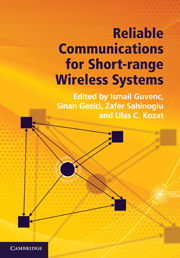Book contents
- Frontmatter
- Contents
- List of contributors
- 1 Short-range wireless communications and reliability
- Part I High-rate systems
- 2 High-rate UWB and 60 GHz communications
- 3 Channel estimation for high-rate systems
- 4 Adaptive modulation and coding for high-rate systems
- 5 MIMO techniques for high-rate communications
- Part II Low-rate systems
- Part II Selected topics for improved reliability
- Index
5 - MIMO techniques for high-rate communications
from Part I - High-rate systems
Published online by Cambridge University Press: 01 June 2011
- Frontmatter
- Contents
- List of contributors
- 1 Short-range wireless communications and reliability
- Part I High-rate systems
- 2 High-rate UWB and 60 GHz communications
- 3 Channel estimation for high-rate systems
- 4 Adaptive modulation and coding for high-rate systems
- 5 MIMO techniques for high-rate communications
- Part II Low-rate systems
- Part II Selected topics for improved reliability
- Index
Summary
This chapter presents an analysis of the gain in system capacity and reliability that can be achieved with the use of multiple-antenna array systems. The general philosophy of multiple-input multiple-output (MIMO) systems is introduced and practical design considerations are highlighted. We focus on two short-range wireless communication technologies of interest and promise, namely ultrawideband (UWB) and 60 GHz systems, and discuss them in the context of MIMO systems. Based on measurements and simulations, we discuss the propagation channel conditions and investigate their impact on MIMO performance. An important aspect of the propagation channel is its spatial correlation, which we analyze in detail and draw conclusions for MIMO array design. For our candidate communication schemes, we investigate MIMO transmission strategies such as time-reversal, beamforming, and waterfilling, and evaluate the corresponding performance improvement. We provide physical insights into the results and make recommendations for the practical design of future wireless systems based on UWB and 60 GHz MIMO techniques.
Principles of MIMO systems
Boosting the capacity and reliability of a wireless link has been a topic of great interest for several decades in communications design. The use of multiple-antenna or MIMO arrays in wireless systems has attracted attention owing to the potential for increasing performance [1–4]. After excessive interest in the last decade, MIMO techniques now form part of many current narrowband and wideband wireless standards and applications, some examples of which are the IEEE 802.11n WiFi and 802.16e WiMAX systems, and a host of proposed 4G systems.
- Type
- Chapter
- Information
- Reliable Communications for Short-Range Wireless Systems , pp. 113 - 136Publisher: Cambridge University PressPrint publication year: 2011



